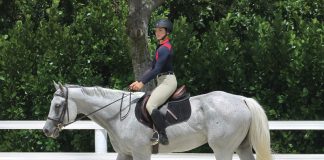Q. What is the difference between a side check and an overcheck? Do they make a huge difference in performance or purpose?
The overcheck is a strap that goes from the “water terret” or middle terret on the driving saddle, up the horse’s neck, between his ears, down the front of his face and splits at the bridge of his nose and goes to the rings of a bridoon bit. It is designed to keep a horse’s head up so he can’t canter or buck. Unfortunately, some people use this piece of equipment without knowing how to adjust it.
 Depending on how tight an overcheck is adjusted, it can be very harmful to a horse. If he can’t get his head down low enough to raise his back, then he’ll have trouble pulling a carriage up a hill or even starting one on flat ground. Think of pulling a sled up a hill by dragging it by a rope over your shoulder; you would have to lean forward to be most efficient. You wouldn’t want to have to pull that sled with your back arched. A badly adjusted overcheck does the same thing to a horse.
Depending on how tight an overcheck is adjusted, it can be very harmful to a horse. If he can’t get his head down low enough to raise his back, then he’ll have trouble pulling a carriage up a hill or even starting one on flat ground. Think of pulling a sled up a hill by dragging it by a rope over your shoulder; you would have to lean forward to be most efficient. You wouldn’t want to have to pull that sled with your back arched. A badly adjusted overcheck does the same thing to a horse.
Back in Black Beauty’s days, the style was to set driving horses heads very high, so the drivers cranked up the overchecks to make the horses look spirited with high heads. All this did was cause major pain to the animals due to the unnatural position.
The overcheck pulls the bit up in the horse’s mouth, and the reins pull backward in his mouth. If you add a running martingale, as so many breed classes want you to do, then you’re also pulling down on the same horse’s mouth all at once. Ouch!
The other main problem with overchecks is that they don’t allow the horse to turn his nose, so bending through a corner becomes almost impossible. This makes the horse lose his balance through turns and he will become very defensive over time about where to put his feet and balance.
If you must use an overcheck to conform to a breed class requirement, please keep it very loose and train your horse to perform the way you need him to instead of forcing him into an unnatural and uncomfortable position.
A side check, which I think is also permissible in most breed classes instead of an overcheck, is much kinder to the horse and will also prevent him from putting his head down. But this one goes from the middle of the driving saddle, up along both sides of the horse’s neck to a loose ring on the sides of the brow band of the bridle, and then down the sides of the horse’s face to a bridoon or regular driving bit. The side check allows the horse to put his head down enough to start the carriage and to pull it up hill. It also allows his nose to move to the inside on turns so his balance isn’t as compromised as with an overcheck. You still have to be careful not to adjust it too tightly. A side check is good for a horse who wants to eat grass when driving, but this problem can also be fixed with proper training.
Remember, any kind of check is just a training device and is not meant for long-term use. If you want your horse to drive with his head up high, train him to use himself from behind and learn how to harness his energy instead of checking him up mechanically.
If you have a small child driving, and the pony wants to eat grass all the time, as ponies sometime do, use a side check, but loosely.
Overchecks are not allowed at American Driving Society, United States Equestrian Federation or Fédération Equestre Internationale sanctioned events. Check your rule books for accepted uses.
Learn more about driving expert Muffy Seaton >>







i live where Amish and other horse-and-buggy people drive by quite often! it looks ssoooo cruel when the come by and the horse’s nose it up in the air! don’t they understand that it’s like ‘harder’ to pull with the over check so tight?? some people i just don’t understand :~(
Excellent article Muffy. So many people just attach the overcheck or side check because it came with their harness.
So if you buy a bridle WITHOUT either of them it will still work? (Like steering and stuff) Also I wouldn’t want to get the over check. If anything it would be the Side check. I am still a bit confused though. Do you have to have either of them? Or can you go without a side check or over check? Thanks please answer! 🙂
Thanks
Kaitlyn I’ve been driving for 25 years and never ever used either kind, you don’t need them and are better off without them. Your horse will thank you.